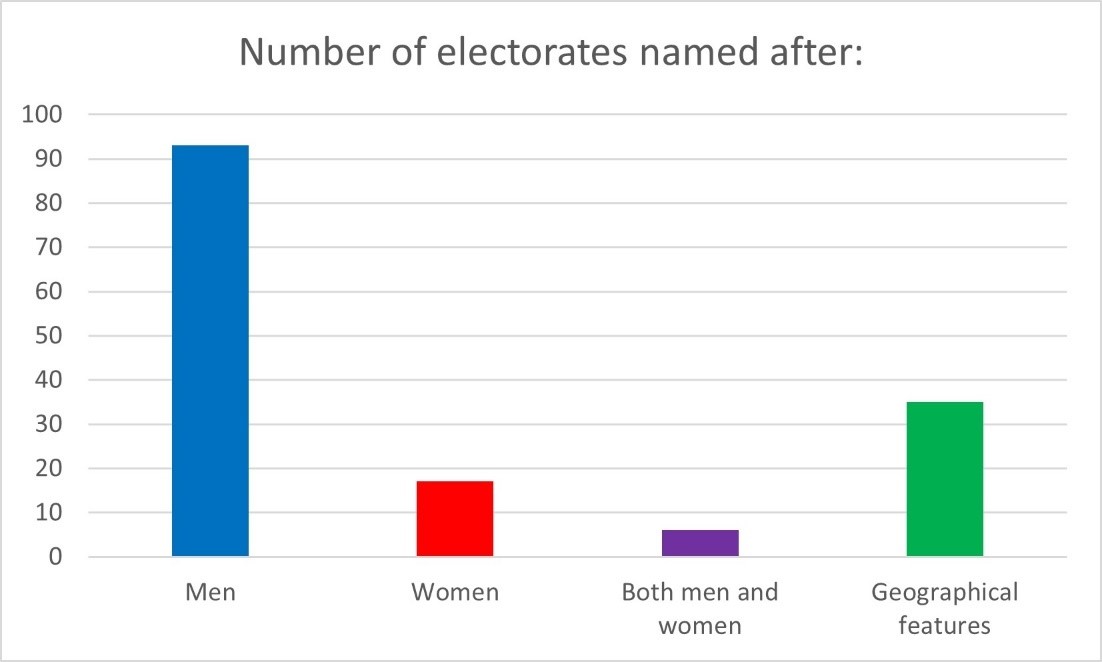Posted 31/05/2023 by Kate Laing and Anna Hough
Federal redistribution processes provide an opportunity to introduce new electorate names, either by renaming existing electorates or naming new ones. Recent redistribution processes, including those in Victoria and Western Australia in 2021, have included calls for more diverse electorate names to honour more women and Aboriginal and Torres Strait Islander peoples. This Flagpost article examines the electorate naming processes, current levels of diversity, and commentary advocating for change.
Australian Electoral Commission Guidelines
The Australian Electoral Commission’s (AEC) guidelines for naming federal electoral divisions recommend against changes ‘without very strong reasons’. However, if necessary, the AEC suggests ‘divisions should be named after deceased Australians who have rendered outstanding service to their country’, including consideration of former Prime Ministers. Additionally, the guidelines state that: ‘Every effort should be made to retain the names of original federation divisions.’
The AEC adopted the guidelines following the recommendations of the Joint Select Committee on Electoral Reform’s 1987 report reviewing the 1984 General Election. The parliament was expanded before that election, with 29 new seats created and 6 abolished, allowing for a wave of new names to be chosen. Of these, 10 were named after women and 16 named after men.
The emphasis on commemorating deceased former Prime Ministers (none of whom are women) and maintaining ‘federation’ electorates has limited what is logistically achievable in creating more diverse electorate names. Though not binding, since the guidelines came into effect 27 new seats have been named, 19 after men (3 Indigenous), 4 named after women, 3 named after families (Burt- all men, Durack which included author Mary Durack, and Nicholls which is named after Douglas and Gladys Nicholls both prominent Indigenous leaders), and one named after a geographical feature.
The statistics of the current Parliament
Australia’s House of Representatives currently comprises 151 Members of Parliament, each representing a single electorate. Of these, 36 (24%) have an original Federation electoral division name. The newest electorate, Hawke (Vic)—named after former Prime Minister Bob Hawke—was established in 2021. Of the 151 current electorates, 35 are named for geographical features (23%).
The remaining 116 electorates (77%) are named after one or more people, as illustrated in the chart below.

Source: Data compiled by the Parliamentary Library from the Parliamentary Handbook of the Commonwealth of Australia, Department of Parliamentary Services (Canberra: DPS, 2022).
Of the 116 electorates named after people, 93 are named after one or more men (80%), 17 are named after women (15%) and 6 are named after both men and women (5%). Of the 93 electorates named after men, 22 are named after deceased former Prime Ministers.
The six electorates named after both men and women are: Canning (WA); Durack (WA); Hasluck (WA); Lyons (Tas); Macarthur (NSW); and Nicholls (Vic). One of the ways that diversity has recently been increased has been by changing the naming justifications for electorates that were named before the modern naming conventions were in place. For example Canning was originally named in 1949, but expanded in 2021 (p.35) to include honouring Sadie Miriam Canning, an Indigenous woman.
Eight electorates (6%) are named after an Aboriginal or Torres Strait Islander person.
Multiple commentators have spoken out against the disproportionate levels of diversity in commemoration. For example, the University of Canberra Professor Kim Rubenstein, an ACT independent senate candidate in 2022, stated in a March 2023 op-ed that ‘the way cities memorialise individuals also reflects on the continuing lack of full gender equality in our society.’ She specifically noted that in 2018 Canberra’s third federal division was named after Charles Bean, rather than the only short-listed woman, Aboriginal activist Ngingali Cullen. Additionally, prior to Hawke’s establishment as a federal electorate in 2021, Professor Clare Wright declared in an op-ed that:
We have enough electorates named after dead white men. It's time we chose a woman instead … Why else would our forefathers have been so intent of reserving the lion’s share of geographic names in Australia for men if there was no real value in the symbolic real estate?
The recent Dame Enid Lyons and Dame Dorothy Tangney sculpture unveilings—the first non-royal women honoured with statues in Canberra’s Parliamentary Triangle—further highlighted the absence of women in public and political commemoration.
During the current Parliament, electoral redistributions are expected for Western Australia, Victoria, New South Wales, and the Northern Territory. Population projections based on the 2021 Census further suggest that New South Wales and Victoria will both lose a seat in the federal Parliament and Western Australia may gain one. Accordingly, these are likely to see renewed calls for adding more diversity to those who Australia chooses to commemorate.